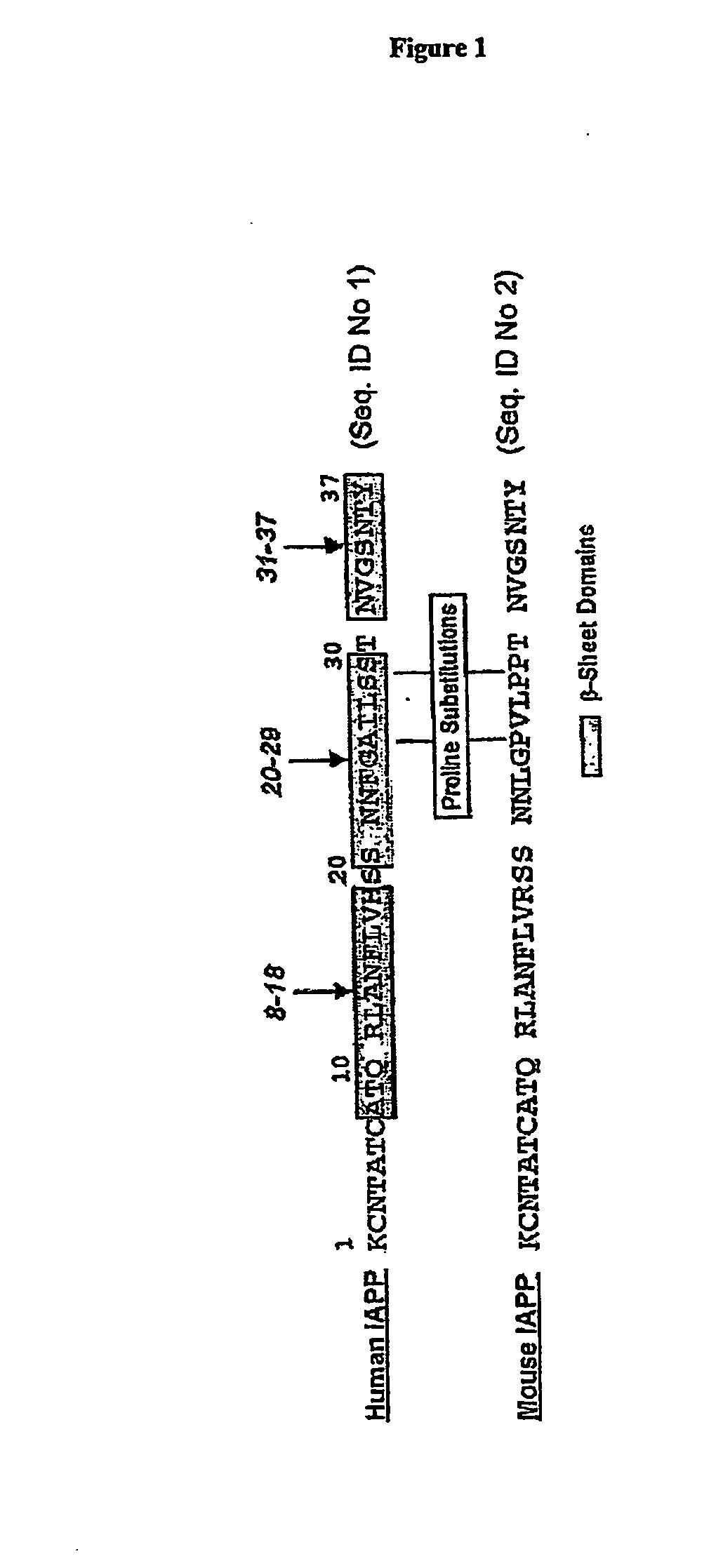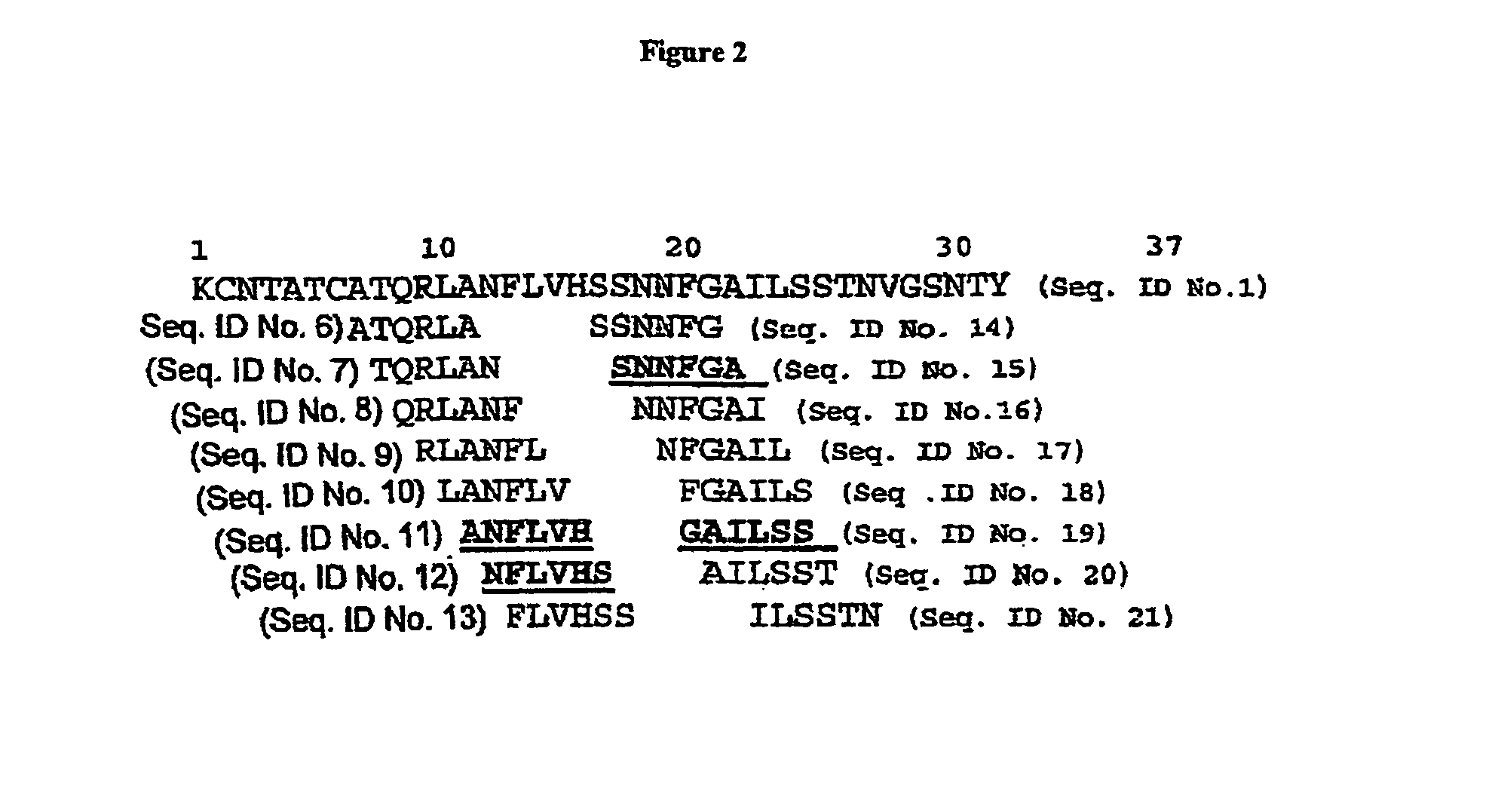Inhibitors of Amyloid Fibril Formation and Uses Thereof
a technology of amyloid fibril and inhibitory effect, which is applied in the direction of peptide sources, tetrapeptide ingredients, tripeptide ingredients, etc., can solve the problems of inability to significantly dissolve amyloid deposits in situ, amyloidotic fibrils, once deposited, and amyloidosis, etc., to achieve the effect of inhibiting amyloid deposit formation and amyloidosis, preventing, and/or reducing
- Summary
- Abstract
- Description
- Claims
- Application Information
AI Technical Summary
Benefits of technology
Problems solved by technology
Method used
Image
Examples
example 1
Minimal Inhibitory Peptide Sequence
[0141] Hexapeptides are considered too large to be effective inhibitors under physiological conditions; a smaller active subunit contained within the active hexapeptide ANFLVH (SEQ. ID. NO 11) is more useful. To identify such smaller active subunits, systematic truncation of individual hexapeptides was performed. The complete series of truncated ANFLVH (13-18) (FIG. 3) was investigated using the in vitro assays as described above (CD, EM, and cell toxicity), over a typical dosing range (molar ratio from 1:1-1:20). The results from this study identified the more active domain(s) within the larger hexapeptide. Three sub-fragments—ANFLV (SEQ. ID. NO. 22), ANFL (SEQ. ID. NO. 23), and ANF (SEQ. ID. NO. 24)—were synthesized and examined in the RIN-cell toxicity assay using exogenous IAPP (FIG. 6). This initial study demonstrated that truncated peptides can exhibit activity comparable to the longer precursors. Each of these peptides showed activity, the ...
example 2
Residue Specificity and Optimization
[0142] Not wishing to be bound by any particular theory of the peptide fragments' mechanism of action, it is proposed that binding to IAPP disrupts the normal packing of the polypeptide backbone and / or side-chain interactions within the fibrils. However, the exact structural basis for these interactions is not known, and it is conceivable that slight modifications in the inhibitory peptides may improve binding and / or render the peptides more effective at disrupting the amyloid polymer packing. To address this possibility, a combinatorial approach was examined by substitution of each residue within the active sequence. All naturally-occurring amino acids can be used to generate a peptide library in an effort to optimize the activity of the peptide inhibitors.
[0143] Based upon the results from the truncation study, the most active peptides (e.g., tripeptides, tetrapeptides) can be systematically substituted at each residue with a different amino a...
example 3
Small Molecule Analogues of Peptide Inhibitors
[0147] Due to low bioavailability and peripheral degradation, peptide treatments present a number of problems for drug development. Translating peptides into a small molecule mimetic is often difficult, due to the typical size of the active sequences (hexamers and larger). Tripeptides, however, display significant activity, and are in a molecular weight range more tractable in terms of predicting the active structure and equivalent small molecule analogues.
[0148] The approach to generating small molecule analogues involves molecular modeling and energy minimization, in order to obtain a likely structure of the peptide fragment. Using this as a template, it is possible to synthesize chemically a small organic molecule that resembles this structure. Any inhibitory molecule may then be optimized using standard structure-activity-relationship approaches based upon the original organic compounds.
[0149] Alternatively, a direct structural ap...
PUM
| Property | Measurement | Unit |
|---|---|---|
| pH | aaaaa | aaaaa |
| pH | aaaaa | aaaaa |
| pH | aaaaa | aaaaa |
Abstract
Description
Claims
Application Information
 Login to View More
Login to View More - R&D
- Intellectual Property
- Life Sciences
- Materials
- Tech Scout
- Unparalleled Data Quality
- Higher Quality Content
- 60% Fewer Hallucinations
Browse by: Latest US Patents, China's latest patents, Technical Efficacy Thesaurus, Application Domain, Technology Topic, Popular Technical Reports.
© 2025 PatSnap. All rights reserved.Legal|Privacy policy|Modern Slavery Act Transparency Statement|Sitemap|About US| Contact US: help@patsnap.com



